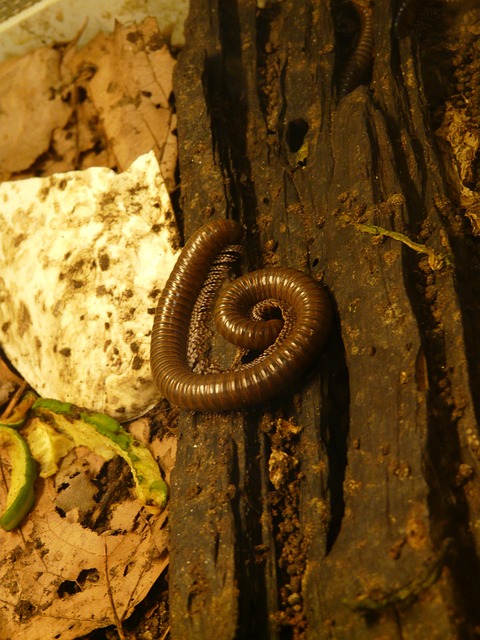Millipedes, often overlooked but prevalent in homes, thrive in damp, dark spaces like basements, bathrooms, and kitchens, entering through cracks and gaps. Effective residential millipede extermination involves identifying entry points, reducing humidity, eliminating food sources, and creating an inhospitable environment. Traditional chemical pesticides have environmental and health concerns, but innovative methods like heat treatments and biological control using natural predators offer eco-friendly alternatives. Eco-friendly techniques include using essential oils and introducing beneficial insects, while physical barriers like sealing cracks and regular yard maintenance prevent infestations. Proactive prevention involves sealing entry points, trimming landscaping, maintaining cleanliness, and targeting common millipede habitats.
Millipedes, though tiny, can cause big problems in residential settings. This article explores innovative techniques for effective and long-lasting millipede removal. From understanding their behavior and habitat to comparing traditional vs. cutting-edge extermination methods, we provide eco-friendly approaches that ensure a pest-free home. Learn essential preventive measures to keep these creatures at bay and discover why navigating their labyrinthine trails is the key to a successful residential millipede extermination strategy.
Understanding Millipedes: Behavior and Habitat in Residential Settings
Millipedes are intriguing creatures, often overlooked but prevalent in our residential environments. When it comes to understanding their behavior in homes, knowledge is power when it comes to effective extermination. These invertebrates prefer damp and dark places, making basements, bathrooms, and kitchens common habitats. Their attraction to water sources and organic matter means that they’re drawn to areas with high humidity and decaying plant material.
In residential settings, millipedes often enter through cracks in foundations, gaps around pipes and cables, or even tiny openings in walls. They move slowly and methodically, and while they don’t carry diseases, their presence can be a nuisance and an indication of underlying moisture issues. Effective long-lasting millipede removal requires identifying and addressing these entry points, along with reducing humidity levels and eliminating potential food sources to create an inhospitable environment for these nocturnal invaders, ensuring a successful residential millipede extermination strategy.
Traditional vs. Innovative Extermination Methods
In the realm of residential millipede extermination, traditional methods have long dominated the industry. These include chemical pesticides that target and eliminate these pests through direct contact or ingestion. While effective in the short term, they come with drawbacks such as potential environmental impact, health risks for residents, and the development of pest resistance over time.
Innovative techniques, on the other hand, offer a more nuanced and eco-friendly approach to residential millipede extermination. These methods leverage advanced technologies like heat treatments, which use targeted warmth to disrupt millipedes’ life cycles without harming most other organisms or leaving behind harmful residues. Biological control is another game-changer, where natural predators like certain fungi or insects are introduced to manage millipede populations sustainably. These innovative approaches not only ensure long-lasting results but also prioritize the well-being of both residents and the environment.
Eco-Friendly Approaches for Long-Lasting Solutions
In the pursuit of long-lasting millipede removal, eco-friendly approaches offer a sustainable and effective alternative to traditional methods. These techniques focus on natural deterrents and non-toxic solutions, making them ideal for residential millipede extermination while minimizing environmental impact. One such method involves using essential oils like peppermint or citrus, which millipedes find repulsive; strategically placing these oils around entry points can significantly reduce their presence over time.
Another innovative approach is the introduction of beneficial insects, such as certain species of spiders and mantis, that feed on millipedes. Integrating these natural predators into a residential environment can create a balanced ecosystem where millipede populations are naturally controlled. Additionally, physical barriers like sealing cracks and gaps, along with regular yard maintenance to reduce moisture levels, can be highly effective in preventing millipede infestations from returning, providing a long-lasting solution for homeowners seeking eco-friendly residential millipede extermination methods.
Preventive Measures: Maintaining a Millipede-Free Home
Millipedes are persistent pests that can quickly invade homes, making effective prevention key for long-lasting protection against these creatures. A robust residential millipede extermination strategy starts with maintaining a clean and sealed environment. Regularly inspect your home’s exterior for any cracks or gaps, especially around windows, doors, and utility pipes, sealing them with caulk to prevent entry. Keep landscaping well-trimmed, removing excessive plant matter and wood piles that provide hiding spots for millipedes. Additionally, ensuring proper drainage around your property helps deter these insects by preventing water accumulation, which attracts them.
Inside your home, maintain a clean environment, wiping down surfaces regularly to remove any food residue or spills. Store items in airtight containers, particularly those made of plastic or glass, as millipedes are attracted to organic materials and moisture. Pay close attention to areas like basements, crawl spaces, and kitchens, where these pests tend to congregate. Regular cleaning and prompt cleanup of messes create an inhospitable environment for millipedes, reducing the need for frequent residential millipede extermination treatments.
In conclusion, effectively managing millipedes in residential settings requires a multi-faceted approach. By understanding their behavior and habitat, combining innovative extermination methods with eco-friendly solutions, and implementing preventive measures, homeowners can achieve long-lasting relief from these persistent intruders. Adopting these strategies ensures a millipede-free home while promoting environmental sustainability. For efficient residential millipede extermination, consider a blend of traditional expertise and forward-thinking techniques to keep your living space comfortable and pest-free.
